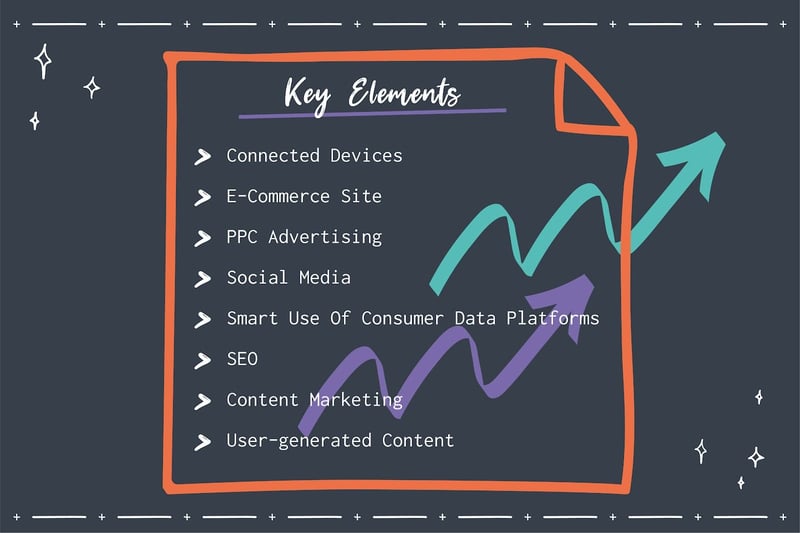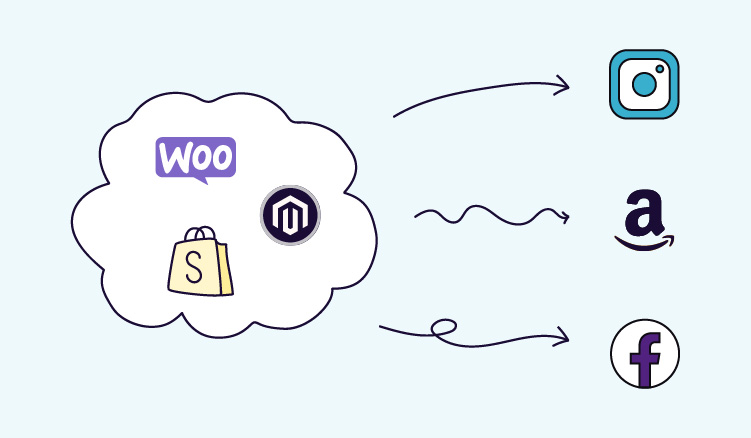While most consumers don’t chase down home furnishings as zealously as The Dude (from The Big Lebowski, if you didn’t know), the average consumer puts a whole lotta love into their homes.
That means there’s money to be made in the home improvement and home design industries. With home improvement retailers expected to bank $409 billion in sales this year (with a predicted climb to $664 billion by 2020), US shoppers are investing in that feng shui at home.
To sink their teeth into that juicy market, brands must reach people.
Enter home furnishings marketing.
What’s the current stay of play? Ecommerce is driving the sales of home goods. Social media platforms are fueling consumer demand for home decor products.
The data tells the tale: 28% of homeowners saw something on their social media feed and made a home improvement-relate purchase at least once in the past year. Digging even deeper, 44% of younger homeowners and nearly 30% of older homeowners reported getting their inspiration from platforms like Instagram and Pinterest.
Home furnishings brands need thoughtful marketing strategies to stay competitive. That’s the job to be done. Here’s how to set up a modern home furnishings marketing strategy that takes advantage of current ecommerce trends while boosting your brand’s unique identity.
Essentials Of A Home Furnishings Marketing Strategy
.jpg?width=800&height=534&name=The-ultimate-marketing-guide-for-home-furnishing-decor-brands-01%20(2).jpg)
You just can’t afford to be a couch potato when it comes to home furnishings marketing.
Pardon the corny joke, but we’re very serious. Dragging your feet in the age of modern ecommerce could doom your home furnishings brand. While there’s a lot to pay attention to out there.
There are certain essentials that will make or break your home furnishings brand’s marketing strategy:
Build A Visual Brand Experience
You’d better get a top designer.
Your visual branding is a key part of the experience you deliver to customers. From your color scheme and fonts to your images and logo, your internal design strategies should focus on gaining recognition from potential customers:
- Color scheme: This is where emotions and feelings come into play for customers. Set the mood for your business by intentionally conveying the feelings you want customers to walk away with when they encounter your brand.
- Font: Consistency is the key here. An awful lot of brands deploy an unwieldy number of different fonts throughout their marketing materials. Set those header and copy fonts and stick to them. Don’t go beyond more than two different fonts to showcase your brand. You can use a font generator to help you decide on a font that matches your brand identity, but make sure not to overdo it.
- Images: Here is where you showcase your work. Taken together, the images you use should be high-quality and should demonstrate a strong portfolio for your brand. Be sure to keep align both digital and print here as well.
- Logo: Think of this as the first impression for your brand. It’s typically the first representation of your brand that potential customers see. Work with a professional to develop a logo that reflects the personality and values of your brand. Make sure that your logo looks good as a tiny image (say, on a business card) as well as on a big banner.
This a chance to make your mark in the minds of potential clients. Be sure you stand out with a bold approach to visual design that aligns with your brand.
Find Your Target Audience, Go To Them
Invest in some high-quality market research to determine your target market.
Know their age range, where they live, how much money they make, what their hobbies are and what their pain points are. Gain as much insight about them as you can at the outset. This will help you better target your marketing campaigns. It’ll also save you marketing dollars in the long run by keeping you focused on customers more likely to buy your products.
The bottom line is that potential customers will not reach you on their own. Identifying them correctly and building strategies to effectively reach them is a critical starting point.
Create A Comprehensive Marketing Strategy
This is where you strike a balance.
Once you know your market and where they live, you can set your strategy accordingly. Traditional marketing outlets such as print, radio, and television are still a thing because many potential customers aren’t as active online.
Don’t miss out on older generations of customers by blowing your entire budget on digital marketing. Toss at least a little budget towards these tried and true marketing tactics.
To be clear though, the bulk of your spending ought to be on digital marketing.
Brands that don’t grow their capacity to reach customers digitally are losing sales. It’s that simple. In the Age of Amazon, it’s all about SEO, PPC, rich content like videos and podcasts, and other tools to enhance the customer experience.
Home furnishings brands must virtually become their own media outlets to attract customers. It’s tough out there.
Don’t fret.
There are lots of talented marketing agencies and freelancers out there to help you build and leverage these marketing assets to secure those customers. As you build a strategy with them, ensure that it blends traditional and online marketing tactics aligned to your customer base for the biggest impact.
Train Your Sales Team Well
Yes, you should think of your sales team as part of your home furnishings marketing strategy.
They’re the ones at the last leg of the buying journey. They use marketing materials to close the deal. Your leads won’t amount to much if they’re not converted to actual sales.
A sales team that is well-educated about your products will be better equipped to deftly guide customers through that purchasing process. They need to know precisely why customers should choose your product over a competitor’s item.
Here it’s important to communicate with your sales team about what resources they need to convert potential customers. We’ll discuss this more below, but remember to train your sales team across multiple platforms (phone, chat, in-person, etc.) so that they can resolve customer concerns in virtually any venue and bring in that revenue.
Be Social, Be Mobile
It’s an omnichannel world these days.
Your customers will expect to connect with you on their desktop, mobile phone, laptop and in any number of other platforms and venues. Are you ready?
Enabling your brand to authentically engage with customers on the social media platforms and connected devices where they are spending their time will make the difference between success and failure. Determine the venues where your brand will gain the biggest bang for its buck and invest in them.
While it’s tempting to spread yourself too thin, don’t try to be everywhere. Focus on the most important places (on social media and mobile devices) where your customers are living.
Nurture Customer Loyalty
Every brand manager knows one thing:
One loyal customer that keeps coming back to buy from your brand is worth more than a few “passerby” customers that only make that small, quick purchase.
Your home furnishings marketing strategy should prioritize the cultivation of such loyal customers. Loyalty programs should be highly-personalized, using modern data tools, to reach customers at the right times and even predict when they might need one of your products.
A customer’s experience of your brand and its marketing should make them feel like a member of a community that they want to stay engaged with. What they get out of your products and marketing experiences should urge them to further your brand through word of mouth, still the most powerful marketing tool out there.
Bring Your Data Together With A Customer Data Platform
If you’re not using a product information management (PIM) solution, what are you doing?
Seriously. Use one. Come on.
Now that we’re done shaming you, here’s why: How product information is presented to customers (also its accuracy and quality) are massively important aspects of the customer experience.
As ecommerce continues to shape the home furnishings market, the need to harness and disseminate product information as part of an omnichannel marketing strategy will only grow. Getting a handle on your product information and deploying it creatively as part of your marketing strategy will be key to staying competitive in this challenging market.
Marketing Your Home Furnishings And Décor Brand: Key Elements

You see that checklist up there?
Use it.
If your brand isn’t leveraging these tools as part of a comprehensive home furnishings marketing strategy, you’ll have trouble keeping pace with competitors in a rapidly growing and evolving market.
Here are some pointers about the essential elements of a strong home furnishings marketing strategy:
- Set-Up An E-commerce Site
- Be sure to get your site listed in online directories and marketplaces in the relevant product categories.
- Partner with popular online business to expand your site’s reach.
- Create A Symbiotic, Integrated Marketing Strategy
- Run online and offline marketing campaigns that complement each other. Whether it’s direct mail marketing coupled with e-newsletters or sponsoring local events while running a geo-targeted Instagram campaign
- Develop Content That Converts
- Creating a diversified backlog of SEO-optimized content (such as DIY or how-to guides for plucky millennials) will help your brand bring in quality inbound leads.
- The key here is to serve up valuable, educational content for your target audience so customers see you as a resource for their personal home decor goals.
- Leverage Social Media
- Platforms like Pinterest, Instagram, and Houzz are your very dear friends in the home furnishings market. Use them wisely as part of your broader marketing strategy.
- Take the time to build relationships with influencers in a meaningful way. The right partnership will help you amplify and broadcast your brand to a wider audience.
Because success in the home furnishings market means juggling lots of products, you’ll need a great solution to manage all of your product information across multiple platforms. With the right tool, you could significantly increase your sales by boosting customer engagement.
Ask the top home furnishings retailers and they will tell you the bottom line:
Brands that deliver accurate, fast, and responsive communications to customers will win in the home furnishings market. The right product information management tool empowers brands to deliver engaging customer experiences that lead to bigger profit margins.
Don’t be a LAY-Z-Brand. Get on it.
Frequently Asked Questions
- Transparency: Clearly communicate the sustainable processes and materials used.
- Educate: Share the benefits of sustainable products, both for the environment and the user.
- Partnerships: Collaborate with eco-friendly influencers or organizations to amplify your message.
- Certifications: Obtain and showcase eco-certifications to build trust.
- Storytelling: Share the brand's journey towards sustainability, making it relatable and authentic.
Showcasing home decor in real-life settings, or 'lifestyle' shots, can make products more relatable. Here's how:
- Staged Photography: Use well-designed room setups that resonate with your target audience.
- User-Generated Content: Encourage customers to share photos of products in their homes.
- Virtual Staging: Use technology to digitally place products in various room settings.
- Collaborate with Influencers: Partner with home decor influencers who can showcase your products in their spaces.
- Interactive Tools: Offer tools where users can mix and match products to design a virtual room.




